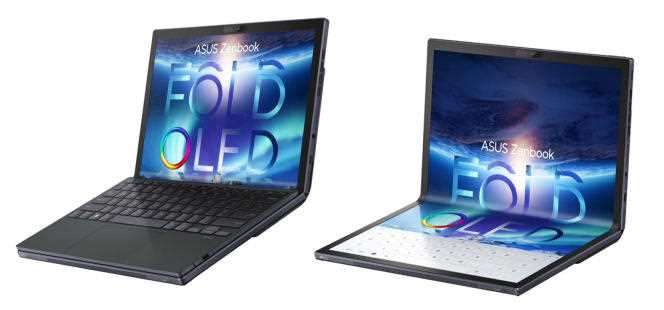The ambition of the Asus Zenbook 17 Fold, unveiled on January 5, is to shake up the design of laptops, whose ergonomics have changed little since the 1990s. To do this, it relies on an OLED screen (organic light-emitting diode, or organic light-emitting diode) of a new kind, flexible and bendable in half, just like that of Intel’s prototype, the Horseshoe Bend (see below), which it looks a lot like.
We had the opportunity to observe Horseshoe Bend at length at the start of 2020, during the Consumer Electronic Show (CES), the electronics show held every year in Las Vegas. Its design had marked us: we guessed its ability to make work more comfortable for the most nomadic users.
Like him, the new Zenbook 17 Fold knows how to be compact. Folded screen, it occupies the space of a 12.5-inch computer, which allows it to be used without discomfort on the train. Rather than typing the texts on the lower part of the touch screen, many users will probably prefer to cover it with the supplied Bluetooth keyboard.
But it is once its screen is unfolded that it reveals its full potential: its display area reaches 17 inches, which allows it to be installed on a table and transform it into a much more comfortable workstation, capable of ‘display two programs side by side. You just have to position your Bluetooth keyboard where you want it.
The Fold then becomes a kind of intermediary between a nomadic PC, with a tiring working position, and a real ergonomic workstation, with a larger screen and positioned higher up.
Astronomical rate
Scheduled for release in mid-2022, the Zenbook Fold 17 is intended for enthusiasts with a full wallet, since it displays the astronomical price of 4,000 euros. Reason why an Asus spokesperson told us that, in the first year, the Taiwanese manufacturer did not plan to sell millions of them, but rather “Test the market”. However, it is possible that this technology is democratized, the price of innovations tending to drop over time. In the long term, for ordinary people, the hope of being able to afford one of their descendants is not prohibited.
The Zenbook Fold 17 is obviously not free from flaws. Compared to a high-end nomadic PC, it is almost twice as heavy (2 kilograms) and turns out to be twice as thick when folded (3.1 centimeters). Its measurements nevertheless remain sufficiently modest so that it can be found a place in most backpacks and other suitcases.
A sensitive question remains: is its flexible OLED screen solid? We are starting to have some perspective on this display technology which has been used on smartphones since 2019. If, for a mobile, it is still a point of weakness, it seems better suited to laptops.
The solidity in question
PCs are equipped with a keyboard and a mouse: you don’t necessarily need to touch the screen with your fingers. Many laptop manufacturers do not even bother to protect their screen with a layer of glass offering better resistance to nails and are satisfied with a layer of plastic, like the Zenbook Fold 17.
In theory, you don’t need to open a laptop computer fifty times a day, unlike a smartphone. The risk of wear of the hinge and of the flexible screen is therefore reduced. Finally, mobiles are intended for our pockets and must therefore be very flat, unlike PCs which can afford a certain overweight. Their designers therefore have more space to fold their screen within their shell: the fold is less straightforward, less fragile, while being less visible to the naked eye, according to Asus.
There is therefore, a priori, less reason to worry about the durability of PCs with flexible screens than for that of foldable smartphones, on the condition of taking care to transport them in a dust-proof cover and small objects. Because it is one of the weaknesses of this display technology: a simple key getting stuck between the two parts of a folded screen can damage it.
